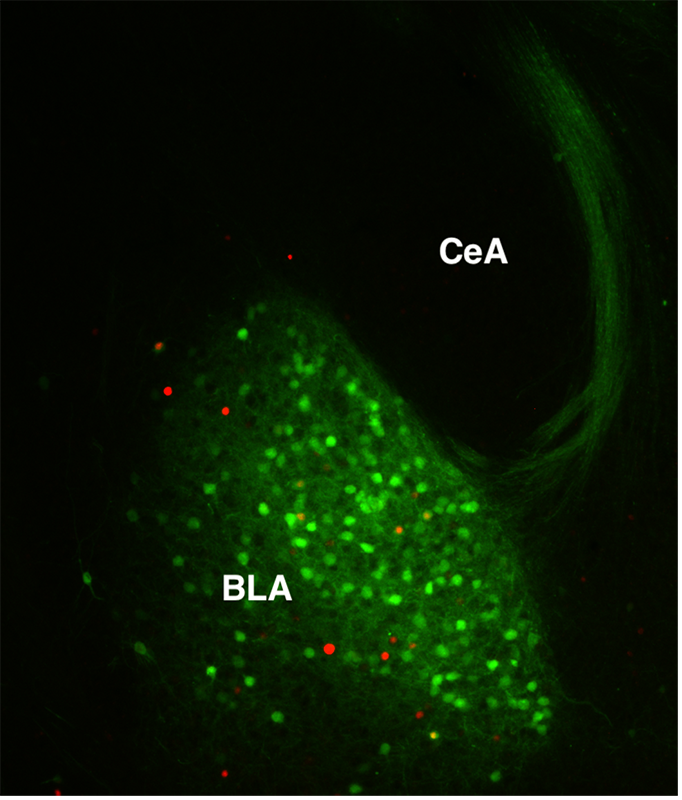By Junghyup (Jung) Suh
For years, our lab has been working on one of the hardest questions in addiction research: Why do people relapse? Think about it – a person can be sober for many years, but one whiff of a familiar place, like the street corner where they used to drink, and the craving overwhelms them. Alcohol addiction, we have learned, is a disease of learning and memory. It involves a powerful, long-lasting memory that can link certain places or other environmental cues with the euphoric experience of alcohol.
We looked at the amygdala, a brain region well-known for its role in emotion processing. More specifically, we studied the basolateral amygdala (BLA). BLA is critical for making and recalling memories, and it is important for connecting cues and rewards. But, despite its size, even smaller than a pinky finger in humans, the BLA is made of tons of different kinds of neurons. We zoomed in on a small, unique subset of BLA neurons that express a protein marker we call Thy1. These appear to be the BLA’s key architects of positive memories, which can drive motivated behaviors.
We used a strong behavioral test, conditioned place preference, to study these neurons. In this test, mice learn to spend more time in a chamber where they got alcohol. Then, we use optogenetics to control the activity of the Thy1 neurons. In essence, this means we put a tiny switch into these neurons that turns off when a certain wavelength of light hits them. So we could instantly stop their activity by shining a laser beam on them. When we did this during the learning phase (alcohol memory formation), the mice never learned to prefer the alcohol chamber. Furthermore, when we turned them off later, during the test phase (memory recall), the mice lost their place preference. We think this is because they could not remember where they got alcohol, as evidenced by the fact that when we returned the mice without switching off those neurons, they still remembered the place. This confirmed our suspicions that the entire process of alcohol memory formation and recall depended on Thy1 neurons of the BLA.
But the BLA is a busy switchboard that sends messages all over the brain. Could one group of neurons really do two very different things – form the memory linking alcohol and place, and then later trigger reward-seeking behavior? We closely examined their outgoing pathways—the neural “wires” or axons coming out of Thy1 neurons–and discovered that they predominantly connected to two far apart brain regions, the nucleus accumbens (NAcc), a part of the brain that processes reward and motivation, and the prefrontal cortex (PFC), a part of brain for making decisions and running things. These distal connections were the big surprise to us since, as a part of a fear circuit we have studied in the past, BLA neurons have been known for their strong connections to the central amygdala, a core amygdala structure known for fear memory formation and recall.

Alcohol stimulated neuronal activity in the amygdala.
A section of brain tissue was obtained from a mouse expressing a fluorescent marker protein in Thy1 neurons (shown in green) after the mouse went through our behavioral experiments. Expression of c-Fos protein (shown in red) was used as an indicator of neuronal activity. Some overlap of red and green in the basolateral amygdala (BLA) reveals that alcohol stimulates some neurons in that region. In contrast to the BLA, the central amygdala (CeA) lacks Thy1 neurons, and to our surprise, Thy1 projections from the BLA circumvent it. This is interesting because it is very different from what we have learned about BLA projections in our other studies, on fear memories, where the relevant BLA neurons are strongly connected to CeA.
To tease apart the roles of the two different outgoing pathways, we decided to do our mouse behavior tests again. But this time we only turned off the signal at the end of one wire and left the other one on. Doing so, we discovered an extraordinary double dissociation: Turning off the NAcc wire only while learning stopped the memory of alcohol from forming. This wire appears to make a new association between the place and the reward. In contrast, turning off the PFC wire only during the test blocked the reward-seeking behavior. This wire seems to be very important for recalling the memory linking alcohol and place and turning it into motivated action.
Our research reveals that alcohol addiction and relapse are not governed by a singular “on/off” switch in the brain. Instead, these conditions involve complex circuits with distinct parts having specific roles. Understanding these particular roles is very important for helping people who have or are at risk of developing alcohol use disorder. We now know that we can aim for very specific targets instead of using blunt, brain-wide treatments. We could focus on the BLA-NAcc learning wire to stop addiction from taking hold, while we could target the BLA-PFC reward seeking wire to stop relapse when a cue is present. By breaking down these complicated neural circuits, we have made a big step toward creating advanced, targeted treatments that can short-circuit the brain’s relapse wires.
Junghyup (Jung) Suh is an Assistant Professor at McLean Hospital and Harvard Medical School.
Learn more in the original research article:
Projection-specific roles of basolateral amygdala Thy1 neurons in alcohol-induced place preference.
Suh J, Flanagan-Burt QC, Moon BK, Pasqualini AL, Zambrano MA, Ressler KJ. Mol Psychiatry. 2025 Aug 29:10.1038/s41380-025-03184-w. doi: 10.1038/s41380-025-03184-w. Epub ahead of print.
News Types: Community Stories
